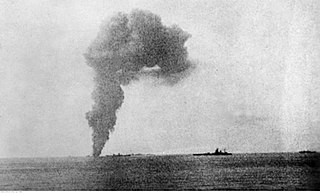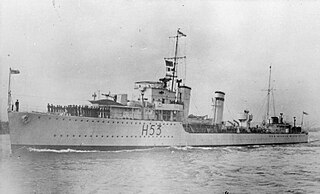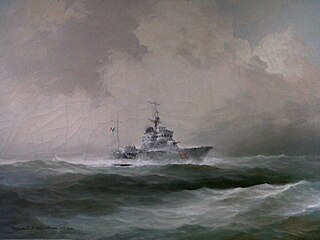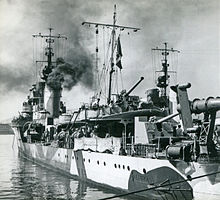
The Battle of the Mediterranean was the name given to the naval campaign fought in the Mediterranean Sea during World War II, from 10 June 1940 to 2 May 1945.
Operation Lustre was an action during the Second World War: the movement of British and other Allied troops from Egypt to Greece in March and April 1941, in response to the failed Italian invasion and the looming threat of German intervention.

The Malta convoys were Allied supply convoys of the Second World War. The convoys took place during the Siege of Malta in the Mediterranean Theatre. Malta was a base from which British sea and air forces could attack ships carrying supplies from Europe to Italian Libya. Britain fought the Western Desert Campaign against Axis armies in North Africa to keep the Suez Canal and to control Middle Eastern oil. The strategic value of Malta was so great the British risked many merchant vessels and warships to supply the island and the Axis made determined efforts to neutralise the island as an offensive base.

HMS Bonaventure was the lead ship of the Dido-class light cruisers built for the Royal Navy (RN) during the 1930s and during the Second World War. Completed in 1940, Bonaventure was assigned to the Home Fleet and participated in Operation Fish, the evacuation of British wealth from the UK to Canada in July. The ship made one short patrol in August into the North Atlantic to search for German blockade runners and followed that up by escorting an aircraft carrier as it conducted air strikes in Southern Norway in September. The next month she was tasked to provide cover for anti-shipping raids off the Norwegian coast. Bonaventure participated in the unsuccessful search for the German commerce raider Admiral Scheer in November and sustained weather damage that caused her to spend time in a dockyard for repairs. She was part of the escort force for Convoy WS 5A in December and helped to drive off another German commerce raider. While searching for stragglers from the convoy, the cruiser sank a German blockade runner.

HMS York was the lead ship of her class of two heavy cruisers built for the Royal Navy in the late 1920s. She mostly served on the North America and West Indies Station before World War II. Early in the war the ship escorted convoys in the Atlantic and participated in the Norwegian Campaign in 1940. York was transferred to the Mediterranean theatre in late 1940 where she escorted convoys and the larger ships of the Mediterranean Fleet. She was wrecked in an attack by Italian explosive motorboats of the 10th Flotilla MAS at Suda Bay, Crete, in March 1941. The ship's wreck was salvaged in 1952 and subsequently scrapped.

《》

The Battle of the Duisburg Convoy was fought on the night of 8/9 November 1941 between an Italian convoy, its escorts and four British ships. The convoy was named BETA by the Italian naval authorities and carried supplies for the Italian Army civilian colonists and the Afrika Korps in Italian Libya.

Vasilissa Olga was the second and last destroyer of her class built for the Royal Hellenic Navy in Great Britain before the Second World War. She participated in the Greco-Italian War in 1940–1941, escorting convoys and unsuccessfully attacking Italian shipping in the Adriatic Sea. After the German invasion of Greece in April 1941, the ship escorted convoys between Egypt and Greece until she evacuated part of the government to Crete later that month and then to Egypt in May. After the Greek surrender on 1 June, Vasilissa Olga served with British forces for the rest of her career.

HMS Sickle was a third-batch S-class submarine built for the Royal Navy during World War II. Completed in 1942, she made her initial war patrol off the Norwegian coast. Sickle then sailed to Gibraltar, from where she conducted one patrol, then to Algiers, French North Africa. From 10 May to 10 October, the boat patrolled the Gulf of Genoa five times and sank a German submarine as well as three minesweepers and an escort ship. She then moved to Beirut, French Lebanon, and conducted two patrols in the Aegean Sea, sinking three caïques and a merchant ship, in addition to landing resistance operatives in Greece.

HMS Dainty was a D-class destroyer built for the Royal Navy in the early 1930s. The ship was initially assigned to the Mediterranean Fleet before she was transferred to the China Station in early 1935. She was temporarily deployed in the Red Sea during late 1935 during the Abyssinia Crisis, before returning to her assigned station where she remained until mid-1939. Dainty was transferred back to the Mediterranean Fleet just before World War II began in September 1939. She briefly was assigned to West Africa for convoy escort duties in 1940 before returning to the Mediterranean. The ship participated in the Battle of Calabria in July 1940 and was assigned to convoy escort and patrol duties until she was sunk by German bombers off Tobruk on 24 February 1941.

HMS Kimberley was a K-class destroyer of the Royal Navy. She served in the Second World War and survived it, being one of only two of the K-class to do so. So far she has been the only ship of the Royal Navy to bear the name Kimberley, after the town of Kimberley, Northern Cape, site of the Siege of Kimberley in the Second Boer War. She was adopted by the civil community of Eastwood, Kimberley and Selston, Nottinghamshire in 1942 after a successful Warship Week campaign for National Savings.

Operation MB8 was a British Royal Navy operation in the Mediterranean Sea from 4 to 11 November 1940. It was made up of six forces comprising two aircraft carriers, five battleships, 10 cruisers and 30 destroyers, including much of Force H from Gibraltar, protecting four supply convoys. It consisted of Operation Coat, Operation Crack, Convoy MW 3, Convoy ME 3, Convoy AN 6 and the main element Operation Judgement.

The Action in the Strait of Otranto [also the Battle of the Strait of Otranto (1940)] was the destruction of an Italian convoy on 12 November 1940 during the Battle of the Mediterranean in the Second World War. It took place in the Strait of Otranto in the Adriatic Sea, between the Royal Navy and the Italian Royal Navy.

The Italian torpedo boat Lupo was a Spica-class torpedo boat built for the Regia Marina in the late 1930s. During the Second World War, Lupo was involved in several naval actions, including that of the eponymous "Lupo convoy", for which she was awarded the Silver Medal of Military Valour. Lupo was sunk in action on 2 December 1942.

The Italian torpedo boat Lince was a Spica-class torpedo boat built for the Regia Marina in the late 1930s. During the Second World War, Lince was involved in several naval actions before she was sunk in August 1943 by a British submarine.

Luigi Biancheri was an Italian admiral during World War II.

Ascari was one of nineteen Soldati-class destroyers built for the Regia Marina in the late 1930s and early 1940s. Completed in mid-1939, she was the last of the first batch of a dozen ships to enter service.

Freccia was the lead ship of her class of four destroyers built for the Regia Marina in the early 1930s. Completed in 1931, she served in World War II and previous conflicts.

The Italian torpedo boat Sagittario was a Spica-class torpedo boat built for the Regia Marina in 1936. During the Battle of the Mediterranean, in the Second World War, Sagittario was involved in several convoy missions, the most notable that known as the "Sagittario convoy", in the course of the Battle of Crete, for which her commander, Giuseppe Cigala Fulgosi, was awarded the Gold Medal of Military Valour. Sagittario survived the war. Re-classified as corvette in 1949, she was scrapped in 1964.
Barletta was an Italian cargo liner built during the 1930s and later became an auxiliary cruiser of the Regia Marina during World War II.





















